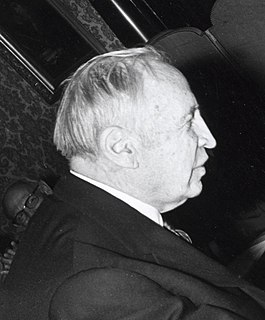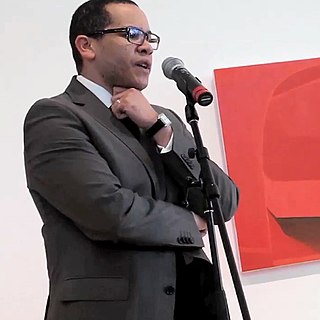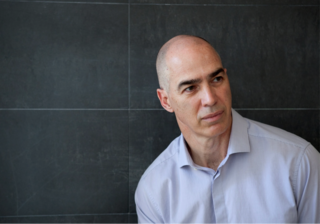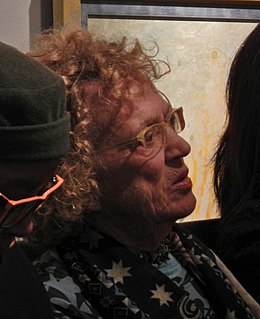
Grant DeVolson Wood was an American painter best known for his paintings depicting the rural American Midwest, particularly American Gothic (1930), which has become an iconic example of 20th-century American art.

John Hasbrouck Van Vleck was an American physicist and mathematician. He was co-awarded the Nobel Prize in Physics in 1977, for his contributions to the understanding of the behavior of electronic magnetism in solids.

Conrad Arnold Elvehjem (May 27, 1901 – July 27, 1962) was internationally known as an American biochemist in nutrition. In 1937 he identified two vitamins, nicotinic acid, also known as niacin, and nicotinamide, which were deficient directly in human pellagra, once a major health problem in the United States. Collectively, nicotinic acid and nicotinamide are termed vitamin B3 and are now understood to be precursors of nicotinamide adenine dinucleotide.

The Chazen Museum of Art is an art museum located at the University of Wisconsin–Madison in Madison, Wisconsin. The Chazen Museum of Art is accredited by the American Alliance of Museums.
John Wilde was a painter, draughtsman and printmaker of fantastic imagery. Born near Milwaukee, Wilde lived most of his life in Wisconsin, save for service in the U.S. Army during World War II. He received bachelor and master degrees in art from the University of Wisconsin–Madison, where he taught for some 35 years. Wilde was associated with the Magic Realism movement and Surrealism in the United States. His darkly humorous figurative imagery often included self-portraits through which he interacted with the people, animals and surreal objects that populate his fantasy world.

Jane R. Hammond is an American artist who lives and works in New York City. She was influenced by the late composer John Cage. She collaborated with the poet John Ashbery, making 62 paintings based on titles suggested by Ashbery; she also collaborated with the poet Raphael Rubinstein.

Arthur Thrall was an American painter and printmaker. His works have been shown in more than 500 exhibits in the United States and abroad including England, Finland, Germany, and U.S. embassies. Milwaukee Journal-Sentinel art critic James Auer said Thrall is one to "defy the dictates of fashion" and "whose high-styled uses of calligraphy rival those of the great age of the Ottomans." His work explores the abstract qualities of the alphabet and recalls "the elegant hand scripts in ceremonial documents and proclamations of an earlier age," re-creating "the tensions and rhythms emerging from a historic document."
Ulfert Wilke (1907–1987) was an internationally recognized painter, museum director and art collector connected to the abstract expressionism movement. He was born in Bavaria, Germany, and immigrated to the United States in 1938. He is best known for his large canvas paintings and highly detailed lithographs that were inspired by calligraphic writing. Wilke was deeply intrigued by the written language, and much of his work was derived from his abstract interpretation of the shapes, colors and meanings of writing that he found in all languages and forms, including the poetry and ancient engravings of Asia and the Middle East. He was an avid art collector, particularly of tribal art, and was the founding director of the University of Iowa Museum of Art.

Edward M. Catich was an American Roman Catholic priest, teacher, and calligrapher. He is noted for the fullest development of the thesis that the inscribed Roman square capitals of the Augustan age and afterward owed their form wholly to the use of the flat brush, rather than to the exigencies of the chisel or other stone cutting tools.
Warrington Wickham Colescott Jr. was an American artist, he is best known for his satirical etchings. He was a master printmaker and operated Mantegna Press in Hollandale, Wisconsin. Colescott died on 10 September 2018, at the age of 97.
Truman Tennis Lowe (Ho-Chunk) was an American sculptor and installation artist. A professor of fine art at the University of Wisconsin, Lowe also served as a curator of contemporary art at the National Museum of the American Indian. He is known for large site-specific installation pieces using natural materials.

Decatur Gibson Byrd (1923–2002), was an American painter of Shawnee ancestry known for landscape and figurative paintings. He was a master of coloristic subtleties and atmospheric effects, and his work often emphasized social commentary and injustice, and the angst and banality of modern materialism.

Leslie Smith III is a contemporary African American visual artist. He currently lives and works in Madison, Wisconsin.

Karl Knaths was an American artist whose personal approach to the Cubist aesthetic led him to create paintings which, while abstract, contained readily identifiable subjects. In addition to the Cubist painters, his work shows influence by Paul Cézanne, Wassily Kandinsky, Utagawa Kuniyoshi, Paul Klee, Stuart Davis, and Agnes Weinrich. It is nonetheless, in use of heavy line, rendering of depth, disciplined treatment of color, and architecture of planes, distinctly his own.

David Klamen is an American artist and academic. He is known for visually diverse paintings that meld technical mastery with postmodern explorations of the processes by which humans understand and interpret experience. Klamen has exhibited across the United States, Europe and Asia, including individual shows at the Museum of Contemporary Art Chicago (MCA), the Chazen Museum of Art and the Cedar Rapids Museum of Art, and major group exhibitions at the Metropolitan Museum of Art, the Art Institute of Chicago, the Museum of Contemporary Art, San Diego, the Indianapolis Museum of Art, and the Crocker Art Museum. His work sits in the permanent collections of the Metropolitan Museum of Art, the Los Angeles Museum of Contemporary Art and the Whitney Museum of American Art, among others. Klamen has been based in Chicago for most of his career, which includes being an educator for over thirty years, primarily at Indiana University Northwest, where he was appointed Founding Dean, School of the Arts in 2018.

Sylvia Fein (Scheuber) is an American surrealist painter and author. Inspired by the quattrocento, Fein paints in egg tempera, which she makes herself. She studied painting at the University of Wisconsin–Madison, where she became part of a group of magical realist painters, including Gertrude Abercrombie, Marshall Glasier, John Wilde, Dudley Huppler, and Karl Priebe. A newspaper described her as "Wisconsin’s Foremost Woman Painter." Beginning in the 1940s, Fein lived for a time in Mexico, then in the San Francisco Bay Area of California, eventually settling in the town of Martinez. Her 100th birthday was marked with an exhibition at her alma mater, The University of California at Berkeley.
Jill Sebastian is an American educational innovator, integrated public artist and multi-media artist.

Santos Ision Jackson Zingale (1908–1999) was an American artist known for his regionalist and social realist paintings.

Martha Nessler Hayden is an American artist, known for Modernist landscape painting and artist books. Hayden lives and works in Sharon, Wisconsin, in a historic Victorian home.

Sylvia Solochek Walters is an American artist and educator. She has produced drawings, paintings and collage works in her career, but is best known for complex woodcut prints created through the "reduction and stencil" process. Her work combines elements of realist, decorative and formalist art, flat and illusionistic space, and varied patterning and textures. She has largely focused on portraits, still lifes and domestic interiors, and collage-like combinations of personal symbolism—concerns that writers often align with early feminist art.














